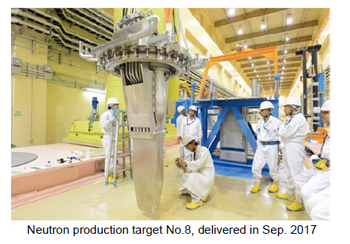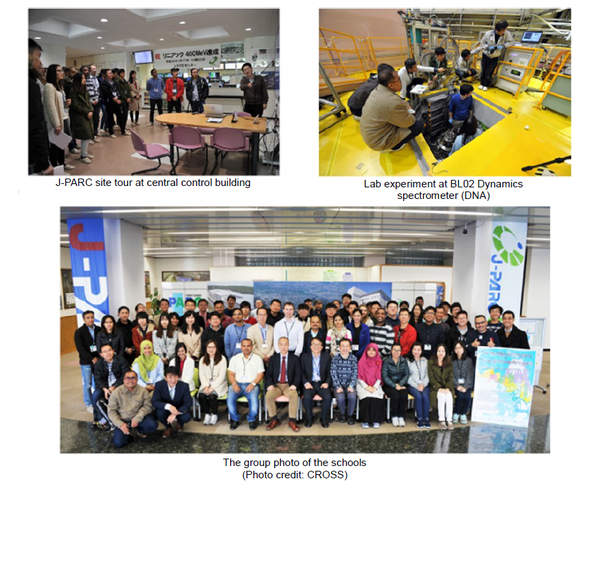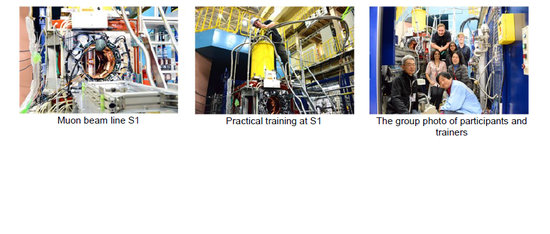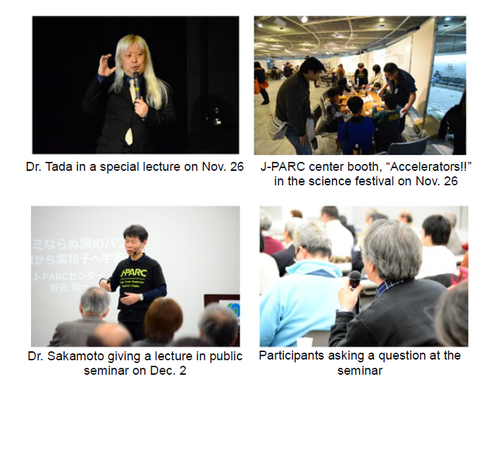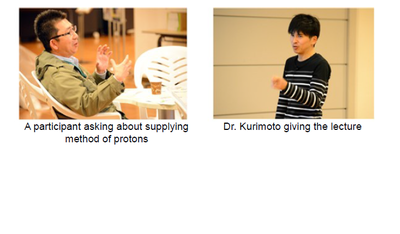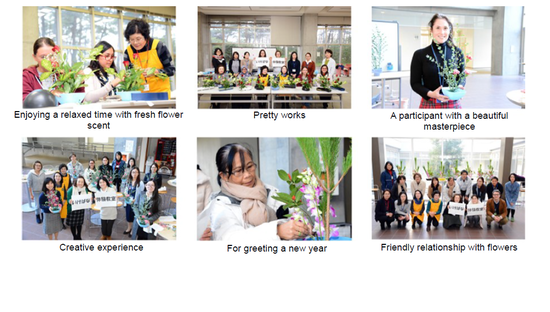J-PARC NEWS December 2017 (Issue #152)
In October, the Materials and Life Science Experimental Facility (MLF) began operation at 300 kW beam power using an improved neutron production target (mercury target vessel). We plan to sequentially increase the beam power while confirming integrity of the vessel. So far, the MLF has gradually increased the beam power up to 500 kW. However, in 2015, a failure occurred in the welding of the target vessel. As a result, the vessel structure and inspection methods were redesigned, and a new target integrated the flow channel of the vessel tip and structure material was completed with an enhanced robustness. Until this new target was completed, we were operating at a low output power of 150 kW using a backup machine. Now, our operation has started, aiming for our first goal of 1 MW.
 ■ The 9th AONSA Neutron School/ 2nd Neutron and Muon School (November 16-20, J-PARC)
■ The 9th AONSA Neutron School/ 2nd Neutron and Muon School (November 16-20, J-PARC)
Co-hosted by the J-PARC Center, the Comprehensive Research Organization for Science and Society (CROSS) and others, the 9th AONSA Neutron School/ 2nd Neutron and Muon School was held at MLF. This school was designed for young researchers and graduate students in the Asia-Oceania region, such as Australia, China, India and South Korea. This time, 50 people from 13 countries participated. The school offered lectures by university professors and conducted lab experiments by dividing the participants into 11 neutron beam groups and a muon beam group. The participants graduated from this school well pleased with the exercises using a pulsed beam.
* AONSA: Asia-Oceania Neutron Scattering Association
■ Technology Award Received at 15th Japanese Society of Neutron Science Awards (December 2, Fukuoka University) 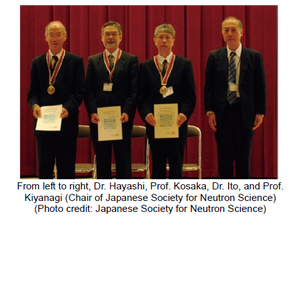
Shinichi Ito, Tetsuya Yokoo, and others from the J-PARC Center's Neutron Instrumentation Section won the Technology Award at the 15th Japanese Society for Neutron Science Awards for their research titled "Construction of HRC (the High Resolution Chopper Spectrometer) and employment of Neutron Brillouin Scattering Methods." HRC (BL12) is an experiment instrument called a chopper spectrometer, and it can separate pulse neutrons by energy levels using a "Fermi Chopper". Also, Michihiro Furusaka, who was at the J-PARC Center during the construction of J-PARC (now at the Hokkaido University), was given the award for "Development of an Advanced Pulsed Neutron Source Spectrometer and Measuring Technique". In addition, Makoto Hayashi (now at the CROSS Neutron Science and Technology Center) won the achievement award for "Development of a Residual Stress Measurement Technique with Neutron Diffraction and Neutron’s Contribution to Industrial Applications." He supervised operations of BL03 and BL20 in 2006 as an Ibaraki prefecture planning division chief engineer and established the Industrial Users Society for Neutron Application.
■ FY 2017 J-PARC Safety Audit (December 4, J-PARC) 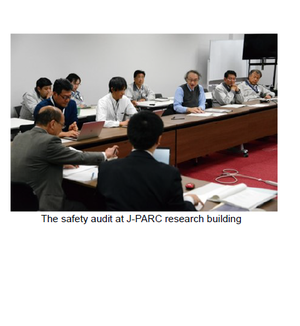
Our 4th safety audit was conducted on December 4 with new external audit committee members, each specializing in safety engineering and radiation safety. At first, the Director, Deputy Directors, Head of the Safety Division and others explained safety management systems, safety activities, radiation control, etc. Next, committee members interviewed at MLF, where many users visit, about safety management of neutron sources and beam usages. The committee members gave valuable comments and proposals at a review session. For instance, it is important to keep compatibility with safety activities for achieving our goals, increasing the power of J-PARC and enhancing contribution for users and society for the next 10 years.
![]()
■ Ph.D. students from Sweden Engage in the Experiment as internship (November 8-13, MLF)
From the 8th to 13th of November, Associate Professor Martin Månsson in Neutron Scattering at KTH Royal Institute of Technology in Stockholm has come to Japan to conduct the experiment at muon beamline SI at MLF, accompanying three of his staff including his graduate students who have engaged in the experiment as internship. Currently in Sweden, the European Spallation Source (ESS), with which J-PARC has signed a memorandum of Collaboration in July 2017, is being constructed. To expand the Swedish user community, the Swedish Foundation for Strategic Research (SSF) has established a Swedish national graduate school (SwedNess) that fully funds up to 40 PhD students, including at least five at KTH. Prof. Månsson is planning to send his students to MLF, saying “Human connections built during the internship shall contribute to promote the stronger relation between Japan and Sweden”.
■ Participated in the 17th Youngsters' Science Festival at Hitachi city and CROSS Public Seminar (November 26 and December 2)
On November 26, the J-PARC Center participated in the 17th Youngsters' Science Festival and presented a booth called "Accelerators!!" Tatsuya Uzumaki from the Public Relations Section and others demonstrated experiments with a gauss accelerator and opened a class to build an accelerator from paperboard and iron balls. As a special lecture, Sho Tada of the Neutrino Section explained how neutrinos relate to space. At the Public Seminar on December 2, which CROSS conducted at Tsukuba City Hall, Shinichi Sakamoto of the Public Relations Section lectured on the principle of neutrino oscillation and gravitational wave observations in relation to water waves. Also, Sho Tada lectured on what J-PARC is pursuing with their neutrino experiments.
■ The 11th J-PARC Hello Science "Howl! Proton Driver" (November 24, Tokai-village Industry and Information Plaza "iVil")
At the 11th Science Café on November 24, Yoshinori Kurimoto from J-PARC Center's Accelerator Section V gave a talk on the proton accelerator at J-PARC. Kurimoto explained at first that accelerator research allows us to understand the mystery of the beginning of the universe, since an accelerator can create extremely high temperature conditions, which may be the initial state of the universe. Furthermore, he explained that J-PARC's accelerator is the world's strongest proton accelerator, which is extremely large and able to accelerate protons close to the speed of light. The Main Ring accelerates protons while synchronizing the proton momentum, acceleration voltage frequency, magnetic field of the electromagnet, and current of the power supply. In addition, for neutrino experiments, development of a power supply system is underway in order to enhance proton beam intensity. The audience gave comments such as, "it was very informative about accelerator regulation methods and more.”
■ Pinecone Christmas Tree Workshop (November 29, Nuclear Science Research Institute, Advanced Science Research Center) 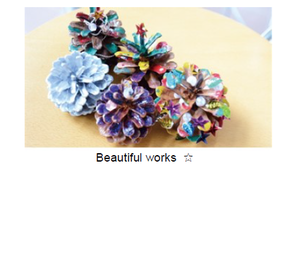
The J-PARC Center offers various classes to foster international exchanges within the organization. This time, we had a pinecone Christmas tree making class, appropriate for the time of Christmas. We prepared fallen pinecones gathered within the facility campus to be used as the body of the Christmas trees. Participants painted them with acrylic paints or paint sprays, and then decorated them with beads and glitter. Participants completed colorful creations with each unique decoration.

■ TIA Flower Arrangement Classes (October 19, November 16, December 21, Atomic Energy Research Institute)
The J-PARC Center held three flower arrangement classes in collaboration with TIA: Tokai-mura International Association and others. Each class had about 15 people in attendance, and the classes become spaces for international exchanges with the researchers who work within the J-PARC Center. Participants attentively worked on the arrangements under the guidance of TIA instructors.

